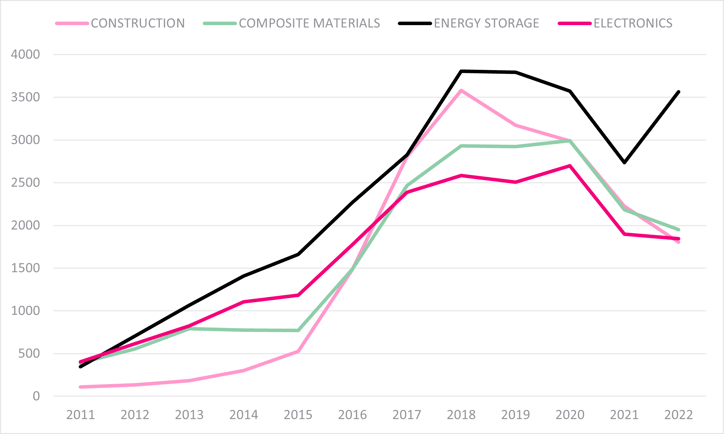Last year, we delved into the data to see how the number of patent publications coming out had evolved in some key areas of graphene application. In a special report, we looked at the construction, composite materials, energy storage and electronics sectors.
We also gathered comments from industry about the impact and development of graphene technologies, including thoughts from James Baker of Graphene@Manchester, Vector Homes, Haydale, Sparc Technologies and more. Our report can be downloaded here.
Since that report came out, an additional year’s worth of data have become available; with more data comes, as always, more analysis.
What does the data show?
Our original report identified that, since about 2018, the rate of ‘graphene’ patent publications in these four areas has levelled off or even started to fall.
A few theories have been floated as to why that should be.
Is it an effect that can be explained by a ‘blunt instrument’ such as the COVID-19 pandemic or general global economic factors? Is it something more subtle, such as innovators companies increasingly retaining trade secrets rather than publishing their developments in patent applications? Is it simply that we have reached ‘peak graphene’, and innovation in the area is finding its steady state after the initial flurries?
One might even blame canny patent attorneys, who increasingly refer to ‘two dimensional materials’ rather than only ‘graphene’.
Almost certainly all of these (and more) contribute in some way; I’m not sure we will ever know “the answer”.
However, the additional data we gathered this year can help us develop a few of those theories.

(Y-axis = number of patent families published globally which mention graphene)
The data for 2022 illustrate one clear stand out: that, while the decline previously noted continued in construction, composite materials and electronics, energy storage bucked the trend and rebounded. So, while publications in the other sectors were still at 2016/2017 levels, energy storage returns to close to its peak.
Of course this could be another ‘blip’, but perhaps it is an indicator.
A shift in global priorities towards climate change and sustainability has driven increased interest in energy storage, as we rely more and more on battery technologies in cars, devices, and large scale energy generation and distribution.
This suggests that, perhaps, the downturn in other areas is economically driven: innovation there is simply not being funded or pursued as keenly as it was 5 years ago.
The new data also help us perhaps downgrade the ‘COVID-19’ effect. Patent applications publish 18 months after filing, and so a slow-down in filing during the peak of the pandemic (2020-2021) might be seen in data from 2021-2022. However if it were a key driver one might expect to see the effect across the board, which we do not. Data for future years might help further shine light on this.
And have we reached ‘peak graphene’? Perhaps the increase for energy storage shows that actually innovation is just shifting to new areas, where ways to harness the advantages and benefits provided by graphene are only just being fully realised.
What does this mean for IP in the future?
Publications remain at relatively high levels, numbering thousands per year in each area, so it is apparent that there is still plenty of room for innovation involving graphene.
That said, something the data cannot tell us is the scope of protection being sought in these applications – has all the ‘low hanging fruit’ already been claimed, leaving innovators to seek increasingly narrow protection? Has the surge seen in recent years left the patent landscape filled with challenging prior art?
With a solid patent strategy, there are still routes to protection even in crowded areas. For example, new combinations or selections can carve out useful protection from inside the scope of broad early patents. New uses or ways of using existing materials can open up new areas for commercialisation and corresponding protection, even if the materials themselves are already known.
If there’s one thing that’s true of graphene, it’s that we have only just scratched the surface of its potential.
|
|
Graphene: patenting a wonder material - Report 2022Our report, based on graphene-related patent publication data from the last 10 years, shows that growth in graphene-based innovation is significant and constant across a range of industries. Graphene is not only being incorporated in existing products in various ways, it is also opening up new possibilities. |
Matthew is a Partner and Patent Attorney at Mewburn Ellis. Working primarily in the chemical and materials science fields, he has significant experience of the intricacies of the EPO. Matthew advises and assists clients with all stages of drafting, prosecution, opposition and appeal before the EPO. Many of his clients are Japanese and Chinese businesses that are seeking European patent protection. These include multinational corporations in the fields of high-performance ceramics and carbon fibre technologies, as well as pharmaceutical and cosmetic companies. Matthew also works with several research institutions and university technology transfer departments across Europe.
Email: matthew.smith@mewburn.com



-3.png)
